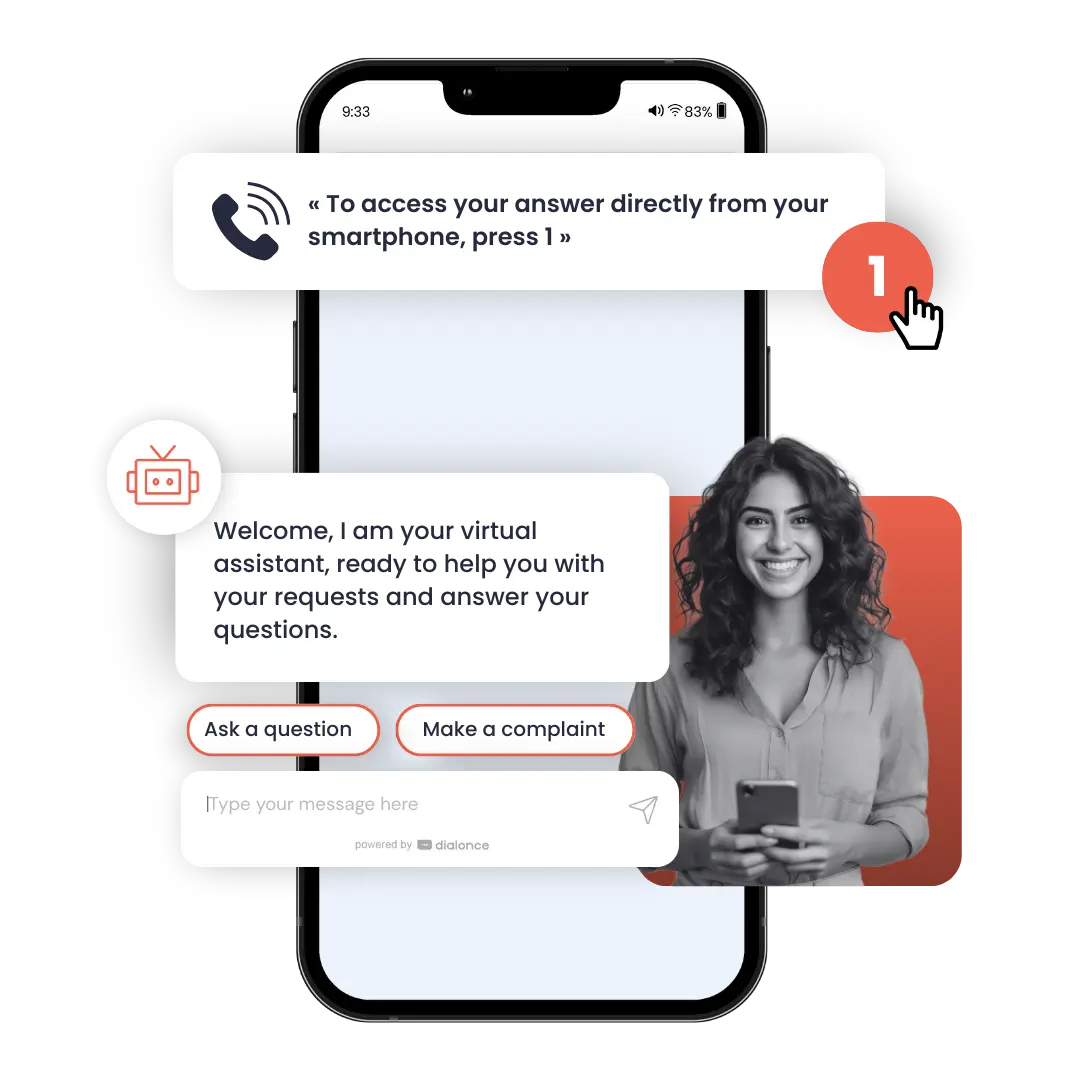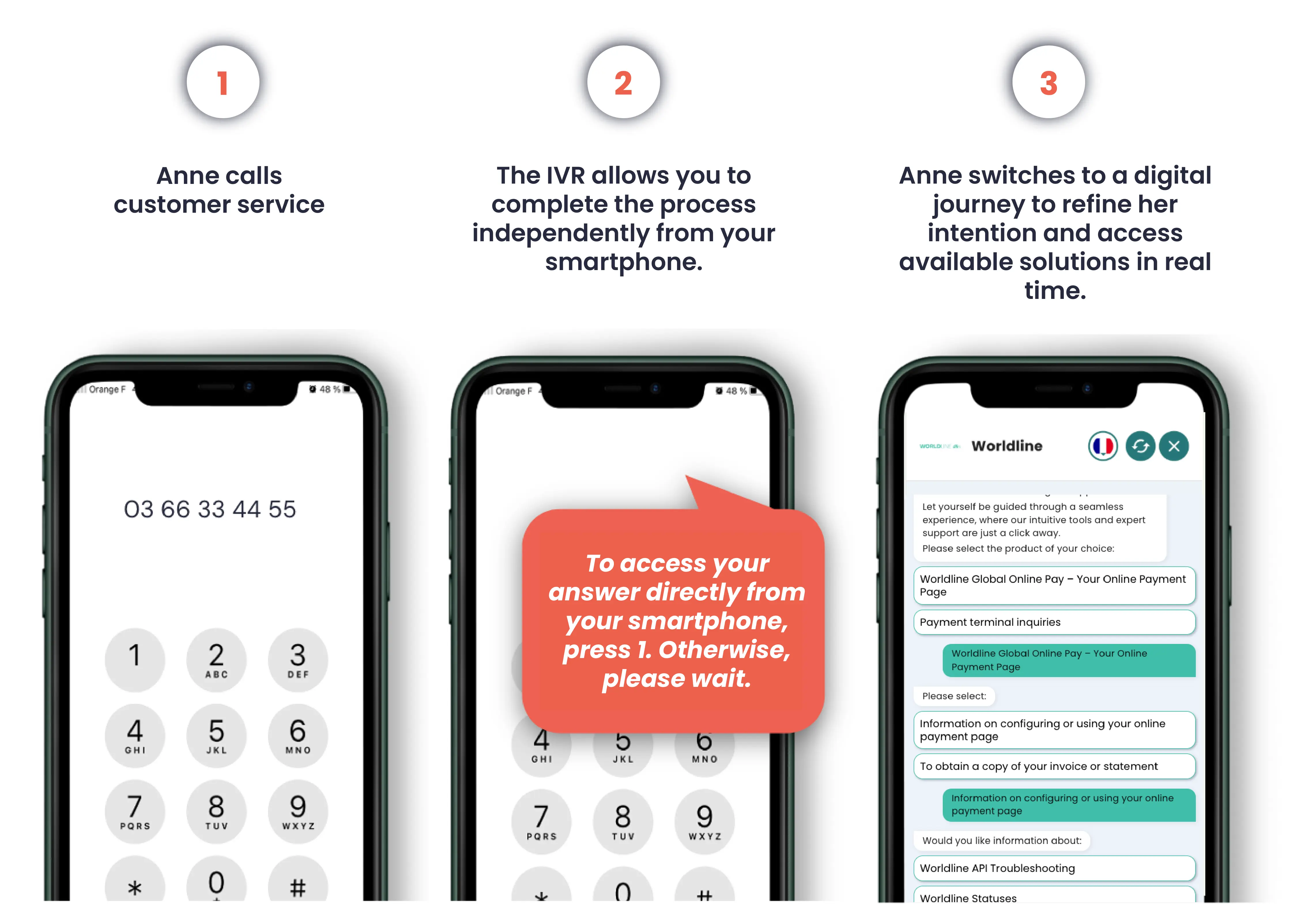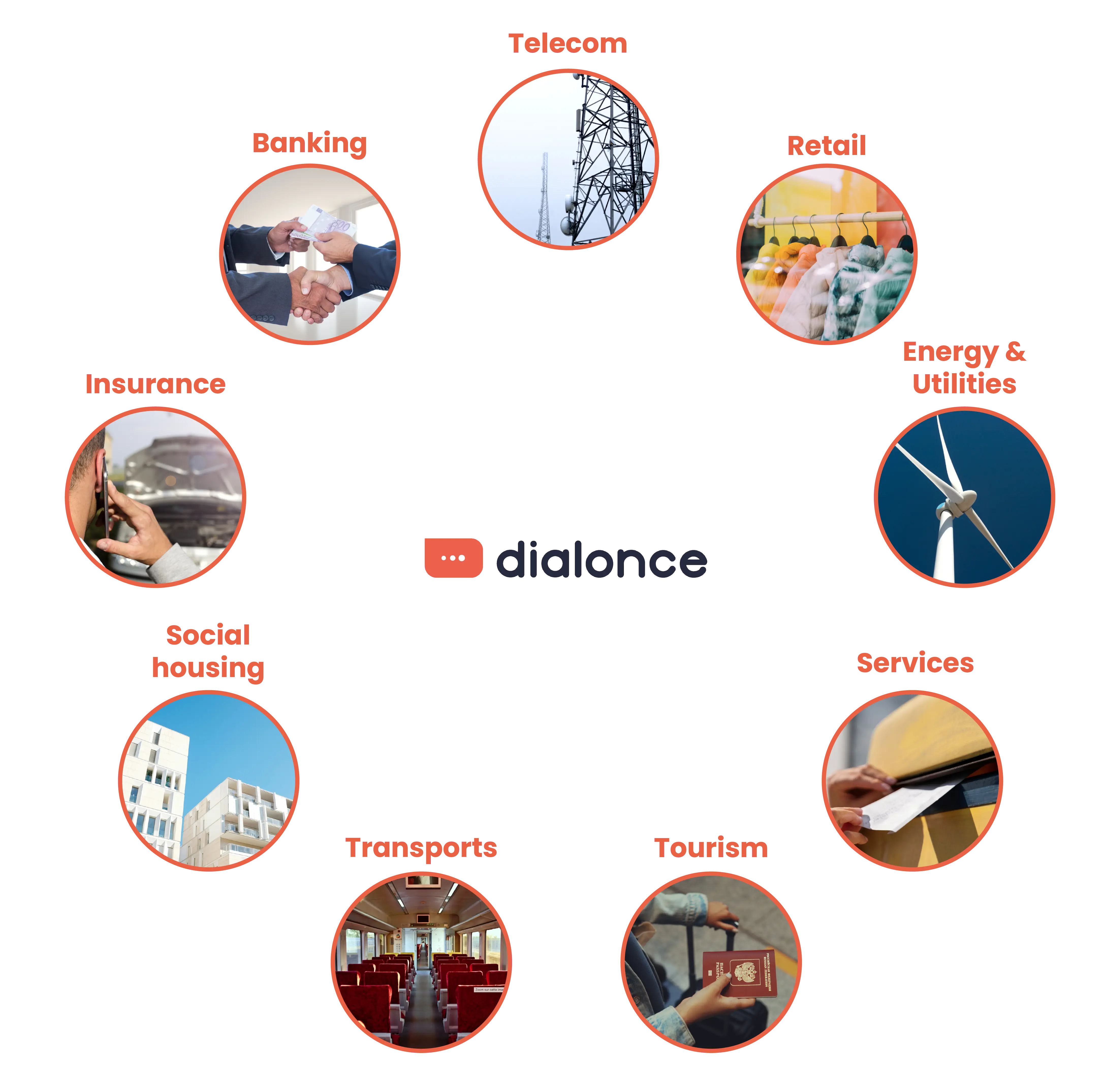As customer expectations for responsiveness and personalization reach unprecedented levels, the traditional phone greeting is showing its limits in terms of adaptability, speed, and comfort for teams. In this context, visual IVR (Visual Interactive Voice Response) emerges as an innovative alternative, combining telephony with an interactive digital interface to streamline call routing from the very first seconds. Already adopted by many major companies in the telecom, insurance, and banking sectors, this technology enables a seamless shift from a phone call to a digital journey, improving both first-call resolution rates and overall customer satisfaction. In this guide, we will take a closer look at what visual IVR is, examining how it works, how it contributes to optimizing customer journeys and service quality, and the key success factors for its implementation.
The Interactive Voice Response (IVR) system is a widely used technology in call centers and customer service departments to automate the routing of customer requests. When a customer contacts a company by phone, they are greeted by an automated voice message offering different options, usually by pressing keys on the keypad or through voice recognition. For example: “Press 1 for Sales, press 2 for Technical Support.”
This system helps reduce the workload of agents by filtering simple or unqualified requests and redirecting high-value calls to the right departments. It also shortens overall wait times and streamlines the caller’s journey. Many companies use it to optimize their call flow management, especially in industries that handle large call volumes daily, such as telecom, energy, or banking.
The traditional IVR, while effective for filtering and routing calls, quickly shows its limits when it comes to handling more complex needs or delivering a smooth, personalized experience. Its journeys are often linear and less suited to the expectations of today’s users, who seek greater autonomy and simplicity. In some cases, the lack of a visual interface can slow down resolution or make the interaction less intuitive. This can reduce the overall efficiency of request handling and negatively impact customer satisfaction. To address these new expectations, a new generation of IVR has emerged, designed to provide users with more autonomy and a smoother experience: visual IVR.
The visual IVR, or visual interactive voice response, is an interactive web interface accessible directly from the caller’s phone. Unlike a traditional IVR, the user does not need to listen to a list of voice options. Instead, they immediately see a clear and structured graphical menu that allows them to select the purpose of their request with just a few clicks.
This visual navigation provides simple and fast access to various actions, such as checking an FAQ, tracking an order, booking an appointment, or reporting a claim, depending on the industry. The visual IVR thus makes self-care (autonomous resolution) more accessible for simple requests, while still allowing the caller to connect with an agent if needed.

Anne calls Worldline’s customer service with a question. Right at the start of the call, the voice server offers her the option to access her answer directly from her smartphone. She then receives an SMS containing a secure, clickable link.
By clicking on the link, Anne is guided to an interactive and intuitive digital journey. She can more precisely select the purpose of her request, access real-time information, ask a question, or book an appointment. In just a few clicks, she either finds the right answer or is redirected to an agent if needed.
This type of solution helps streamline call handling, reduce congestion on phone lines, and provide a faster, more comfortable experience for users, while also optimizing internal team organization.
Its main strength lies in the simplicity of the journey, its continuous availability even outside business hours, and the reduction in handling time. It gives customers greater autonomy, helps companies optimize incoming call flows, and enhances the overall customer experience. Following the implementation of visual IVR, the tour operator TUI improved its reachability in the French market by 29 points.
Traditional IVR works only through the phone: the user listens to a voice menu and responds by pressing keys or speaking. This can sometimes lack flexibility, menus may be long or poorly suited to the caller’s situation, making navigation less smooth. Users may even have to start over several times before reaching the right department, which complicates the journey and increases abandonment rates.
Visual IVR, on the other hand, offers a more modern experience. It appears directly on the caller’s phone screen and allows them to either complete the process autonomously or connect with an agent. Options are immediately visible, and customers can click, read, or interact at their own pace. They can also access forms, FAQs, or a chatbot. The journey is smoother, more guided, and above all adapted to today’s customer habits, especially in moments of stress, mobility, or limited availability. It can also integrate seamlessly with all digital channels, making it a central tool for omnichannel strategies.
Orange Business implemented visual IVR to simplify its call handling. Thanks to this solution, 56% of calls were deflected and redirected directly into a smooth and autonomous digital journey.
According to the DialOnce & Kiamo 2023–2025 barometer, 72% of French consumers say they trust customer service agents reachable by phone, confirming that this channel remains essential for contacting customer support. However, expectations are evolving, and users today are looking for greater speed, convenience, and autonomy in their interactions.

The visual IVR helps reduce congestion on phone lines by directing simple requests to a digital journey, while allowing agents to focus on more complex situations. Customers gain autonomy and comfort: no more waiting times or dependence on business hours, they can easily access what they need, anytime.
Everything is designed to make navigation simple and enjoyable. The visual interface replaces sometimes tedious voice menus with clear, interactive screens. Choices automatically adapt to the customer’s profile, enabling them to go directly to the option they need. This personalized journey saves time, reduces effort, and streamlines the interaction from the very first seconds.
The impact on customer satisfaction is significant: less frustration, a clearer understanding of available options, and faster resolution. Customers more readily express their satisfaction, which translates into a clear increase in key indicators such as CSAT (Customer Satisfaction Score) and NPS (Net Promoter Score), often rising after the implementation of a visual IVR. The visual IVR is also designed to be accessible to everyone, including hearing-impaired users or those not fully fluent in the language, thanks to its multilingual interface and its inherently visual, universal, and inclusive design.
The benefits don’t stop there. From an operational perspective, the visual IVR also helps reduce the costs of Customer Relationship Center by limiting the number of transfers to agents. Simple requests are resolved directly through the interface, relieving teams and boosting productivity. This allows agents to focus on higher-value requests. On average, visual IVR frees up 20% more agent time, which can then be dedicated to more meaningful and complex customer interactions.
Finally, thanks to the data collected on user journeys, companies gain a clear view to continuously adjust and optimize their system, relying on advanced analytics to better understand usage patterns and pain points.

To meet new customer habits and expectations, the visual IVR includes several key features designed to make information more accessible and streamline the entire journey:
The visual IVR adapts to all industries and addresses a wide range of challenges such as handling call peaks, managing recurring requests, enabling faster routing, or improving the customer experience. Here are some concrete examples of applications by industry:
The banking sector leverages visual IVR to simplify the management of frequent requests, such as account inquiries, card renewal requests, or common transactions. By redirecting calls to a digital journey, accessible, for example, via an SMS link, it helps reduce call center congestion. Crédit Agricole Nord de France implemented this solution to ease pressure on its branches and refocus teams on customer relations. Since its rollout, 16% of calls have been redirected to digital journeys, improving both reachability and advisor productivity.
Insurers use visual IVR to guide policyholders toward suitable digital solutions, such as interactive forms or self-care portals. This makes it possible to efficiently automate simple requests such as obtaining a certificate, filing a claim, or tracking a case, while still maintaining easy access to an advisor if needed. Macif deployed a hybrid journey via visual IVR, implemented in just 48 hours, to ensure 24/7 availability and direct members to digital journeys (self-care or form). Today, 22% of incoming calls are digitized, 60% of sessions are handled autonomously, and all calls are processed, whether digital or voice.
The visual IVR is widely adopted in the transportation sector to automatically redirect calls to digital solutions and efficiently handle recurring requests such as schedules, disruptions, or refunds. This system helps reduce congestion during peak disruption periods and improves customer service responsiveness. RATP implemented visual IVR to digitize part of its incoming calls related to passenger services. Today, this solution diverts 38% of calls by redirecting them to the most suitable digital channel.
Implementing a visual IVR is not something to improvise; it requires a structured approach to ensure smooth journeys, measurable results, and large-scale adoption. Here are the key steps to a successful deployment:
First, it is essential to conduct a comprehensive audit of incoming call flows. This involves analyzing volumes by type of request, identifying peak times or abandonment points, and spotting friction in current customer journeys. This step makes it possible to clearly understand where the experience can be improved and where automation is most relevant. Based on this assessment, clear and measurable objectives are set: reducing redundant calls, improving first-call resolution, increasing self-care rates, streamlining call routing, absorbing call peaks, or avoiding call overflows.
Based on the audit, a detailed mapping of existing customer journeys is carried out. This step makes it possible to visualize touchpoints, expressed intents, channels used, and potential bottlenecks. From this mapping, optimized journeys are designed, taking into account user expectations, best practices in digital experience, and business objectives.
The new scenarios focus first on high-volume or recurring use cases such as order tracking, claim declarations, or appointment booking, in order to partially automate them without compromising service quality. For more specific or sensitive requests, the journey provides a smooth redirection to a human agent. This hybridization between digital and human is essential to deliver a balanced, reassuring, and effective experience.
The visual IVR can be triggered by sending a link via SMS or RCS during or immediately after a call. To ensure these journeys are effective, the interface must follow a mobile-first approach: it should adapt perfectly to small screens, load quickly, and allow for immediate understanding. The user experience must be smooth, accessible, and understandable in under three seconds, in order to capture attention right away and minimize abandonment rates. Ergonomics, copy, icons, and tone of voice should all be designed to reassure, guide, and encourage action.
The deployment of a visual IVR can be carried out in-house or by working with a trusted vendor. If you choose the latter, it is essential to collaborate with an experienced partner capable of delivering a solution tailored to your business needs and existing tools. Selecting a skilled provider with the right tools and strong technical expertise ensures a smooth, secure, and customized implementation. A tailored onboarding process also guarantees better alignment with your industry’s specificities, as well as strict compliance with regulations such as GDPR. The ideal partner should also provide ongoing support to evolve the solution over time, while fostering local innovation initiatives.
Interfaces are designed to blend seamlessly with your brand environment, offering clear, intuitive, and mobile-friendly navigation. The entire system connects easily to your existing tools through secure APIs, ensuring consistency and fluidity across customer journeys. Rigorous testing is conducted before the final rollout to validate performance, security, accessibility across all devices, and software reliability during activity peaks.

Once the visual IVR is deployed, data analysis plays a central role in monitoring performance and guiding improvements. Analytics tools make it possible to track key indicators in real time, such as the click-through rate on available options, the resolution rate of requests without human intervention, the abandonment rate during the journey, and the satisfaction levels reported by users.
These quantitative insights are complemented by qualitative feedback (via post-journey surveys, customer verbatims, or field observations), which help to better understand barriers and drivers of engagement. The combined analysis of these elements makes it possible to identify friction points, test new wording or journey variations, and continuously optimize interfaces, content, and scenarios.
The return on investment (ROI) of a visual IVR can be assessed through specific indicators, both operational and experiential. Performance evaluation is based on three complementary dimensions: handling efficiency, user experience, and economic impact.
While visual IVR brings many benefits, a few points of caution should be considered to ensure effective deployment and optimal adoption:

These limitations are in fact opportunities for optimization, which strengthen the impact of a visual IVR when properly anticipated. A progressive, structured, and well-supported approach makes it possible to maximize the benefits without adding complexity to the user experience.
Far beyond its initial role of call redirection, it transforms the phone greeting into a smooth, intuitive, and personalized experience. By reducing agent workload, cutting wait times, and fostering user autonomy, it enables companies to increase efficiency while boosting customer satisfaction.
The visual IVR allows companies to fundamentally rethink customer journeys. It simplifies access to information, reduces redundant call volumes, and improves satisfaction from the very first seconds. Easily integrated into an omnichannel strategy, it ensures a continuous experience across all touchpoints.
In the coming years, the visual IVR will continue to evolve with advances in artificial intelligence and integration with other technologies such as the Internet of Things or augmented reality. It will become an intelligent digital assistant, capable of anticipating needs, personalizing every interaction, and delivering relevant solutions in real time, while strengthening customer closeness.